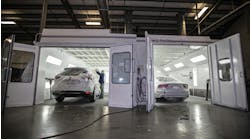What you'll learn:
- Why it's important to calculate paint costs per refinish hour, not the price paid
- How reviewing repair orders for missing paint procedures on the repair order can add tenths of hours (which add up)
- Look for waste from overmixes, which has the double financial penalty of disposal costs
When helping a shop reduce their liquid costs, I generally try to focus on two areas: paint hours per gallon of clear and toner cost per paint hour. Those who have heard me talk about paint costs know that cost is tied to how a product is used, not the price paid. In that respect, two of the highest used items in your mixing room are clears and toners, and everything else is a component of those products. If we can control the costs of those two liquids, we improve your overall paint profitability.
Using a target of 75 paint hours per gallon of clear would cost about $2.45 per paint hour on liquid. However, if you were only getting 60 hours out of a gallon of clear, you would spend $3.06 with a $.61 increase in cost per paint hour. A shop producing 750 paint hours per month would have an additional cost of $457.50 in clear versus a shop maintaining its target goal. That change in cost would reduce your gross profit by 2 percent.
Toner cost per paint hour follows the same premise. Your cost increases when you consume more product when producing the same hours. Toners have a higher cost per paint hour with a $5.70 average, so watching the usage closely is important. Again, by using 750 paint hours per month, a shop on target would consume $4,275.00 of liquid toners. However, a shop consuming the same amount of liquid toners but only producing 725 paint hours would have a $5.90 cost per paint hour. That $0.20 increase would add up to a decrease of just over 1 percent in gross profit.
Neither of these two categories caused a big reduction in gross profit percentage, but you can see how the increased cost per paint hour can be more significant. All of our calculations are based on paint hours, so it stands to reason that one way to reduce your paint costs is to sell more paint hours. When visiting a shop, I have a habit of reviewing repair orders for vehicles in the paint shop. I look specifically at the paint procedures, and while I don’t find full hours to add, I do find tenths of hours. Most of what I find is missed paint processes for refinishing inside of panels, or where basecoat was added to a repair paneled edge without a clear. I also discover damage to adjacent panels that require repair and refinish operations.
A typical door panel repair has 3.3 basecoat paint hours, with 1.1 hours allowed for clear, totaling 4.4 paint hours. The cost for this repair is $18.81 for basecoat and $2.70 for clear, or $21.51 in cost, excluding mixing components. According to MOTOR’s P-pages, the paint allowance is for the outer surface only and does not include the door edge. If the door edge is not documented by the damage appraiser but refinished by the painter, you would not only lose the six tenths in paint hours allowed for the process but $2.93 in associated materials as well. It would not take long for that loss to add up in an average shop producing 200 repairs per month. Ensuring every process completed by the painter is documented on the damage appraisal should be the first step in controlling your paint costs.
As mentioned earlier, the cost of liquid product is based on usage, and how your painters regulate mixes is vital to controlling your paint costs. Another habit I have formed is to look at the paint room mixing table to see how many cups I find with more than two ounces of liquid left in them. Anything over two ounces is considered waste, and action should be taken to reduce the amount remaining in the cup after a refinishing process is completed. Using a panel calculator in your mixing program can help regulate the amount mixed based on the area being refinished. Remember: you pay for paint waste twice – first on your material invoice and again when you pay to dispose of it.
Since paint profitability is always top-of-mind, I hope I have given you some good tips to reduce the dollars you spend by looking at key areas. Sometimes looking at a couple of areas is much easier to manage, especially when there are two that can be very effective at controlling your paint costs. Have a look around your shop and use my recommended habits to see what you will find. Are your damage appraisers documenting all of the accomplished refinish processes? How many paint cups are sitting on your mixing table with more than two ounces of paint remaining? The answers to those questions could provide a lot of insight into how money is truly being spent. Controlling your cost, not price, is the best step to profitability and a stronger future for your shop.




